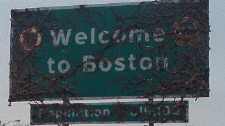The sign in the grassy center divide of the highway said it all. Vines covered the name of Boston and obliterated the population. Nearby, along the far side of the road way, humbled, huddled masses moved in their effort to flee – a sad parade of characters who believe they can somehow escape doom by leaving the heart of the city – an echo and tribute to the original book upon which Steven Spielberg was basing his more modern day version of War of the Worlds.
From this glimpse into the Staten Island shoot, you can see that Spielberg is reaching back to the roots of the story, depicting the critical mass exodus of the population after the social order has failed.
Wells is a social commentator in all his novels pointed out in his chapter called “The Exodus from London” that police organizations, even the mass transportation elements were “losing coherency, losing shape and efficiency, guttering, softening, running at last in that swift liquefaction of the social body.”
In the 1898 novel, people stuffed themselves into trains or any other conveyance that would removed them from danger. People were being trampled and crushed even within a hundred yards of the station.
“Revolvers were fired, people stabbed and policemen who had been sent to direct the traffic, exhausted and infuriated, were breaking the heads of the people they were called out to protect.”
If the book is any measure of the film, then the Staten Island scene which depicts roads leading out of Boston tells gives us two significant hints as the time frame and geography of Spielberg’s movie.
Although these scenes were filmed along a highway within five minutes of the Bayonne Bridge, they represent a five hundred mile leap in geographic location, and a significant passing of time. The sign indicating Boston is covered with vine – with studio workers along the road spreading more vines to quickly age the modern thoroughfare.
In Bayonne, Spielberg filmed the beginning of the invasion. Ray Ferrier – the character Tom Cruise plays – is at home, struggling to repair his car and to raise his kids when the space aliens invade. Although set in the Iron Bound section of Newark, these scenes along with those filmed in the heart of Newark, appear to be part of the opening sequence of violence – leaving downtown Newark in ruins and the block where the Cruise character lives in flames.
The Staten Island scenes indicate a significant passing of time. Civilization has begun to fade. Vines have had time to grow over signs that most commuters would pass daily without notice. Humanity, undefended by mankind’s most powerful weapons, has been reduced to a horde of fleeing people, many of whom are in rags or traveling on broken down bicycles and other transportation modes that survived the early years of the holocaust.
These are not new scenes for Spielberg, and images of what you might expect here might well be found in his masterpiece Schindler’s List. While these scenes still depict some military on motorcycles and such, these scenes are part of the real horror of the film, in which humanity has abandoned hope and the aliens are largely free to hunt people down at will, blasting them from their war machines the way hunters on trains in Wells’ day might have slaughtered buffalo, bringing humanity to near extinction.
These scenes are late in Wells’ masterpiece, and the veneer of civilization has been stripped from human beings. Those stomping along the side of the road were a hopeless mass, “a boiling stream of people, a torrent of human being rushing northward, pressing on another.”
Wells described them in this way.
“There were sad, haggard women tramping by, well dressed, with children that dried and stumbled, their dainty clothes smothered in dust, their weary faces smeared with tears. With many of these came men, sometimes helpful, sometimes lowering and savage. Fighting side by side with them, pushing some weary street outcast in faded black rags, wide-eyed, loud-voiced and foul-mouthed.”
Wells described them as a variety of people in a variety of professions, but all with one thing in common.
“There was fear and pain on their faces and fear behind them.”
We can expect from the Staten Island shoot people reduce to their most savage, stripping away society’s morays to leave only the toughest and most ruthless to survive, kicking each other side to get ahead, even though in the end, none can escape the doom that waits them.
In some ways, the Staten Island shoot may resemble some of those terrible bigger than life scenes of human disaster typical of films like Gone with the Wind with misery magnified by the ever increasing numbers. But unlike films like Independence Day, this is a slow death, with aliens seeming to derive pleasure from the hunt.
- A reader suggested the vine-like things on the sign may well be some growth brought by the aliens and not a sign of great passage of time. This seemed to be the case since the vines have an alien look to them. So in checking back with the Well’s novel, we discovered that the vines seen at the Staten Island scene may well be the aftermath of what is called “Red Weed.” I’ve put out a call for more information and should have photos and details within a few days.
